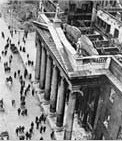Ireland & USA: Little Differences #9
Coin Take Up
The U.S. Mint is trying again. New One Dollar coins are being introduced starting in February 2007.
These new coins will bear the images of four different presidents per year, in the order they served in office.
So far so commemorative, although I note that to be depicted on a coin, a president must have been dead for at least two years. This is presumably because everybody can remember living ex-presidents and the recently deceased, no problem, but once a couple of years go by people are wondering who was he again? Was he the one that wore womens’ clothing whilst plotting the downfall of communism? Or the one who told us that God was in the vegetables, except broccoli?
So yes we’re in lu-lah land again. The U.S. Mint is hoping America’s presidents will finally win acceptance for the one-dollar coin. Hoping. The U.S. Mint is hoping. The Mint also hopes the program will succeed, in part because of the bold designs on the new coins.
Why do these people have jobs?
The Susan B. Anthony dollar, introduced in 1979, and the Sacagawea, introduced in 2000, have failed as circulating coins. As jewellery they’ve been a big hit, but in the US people haven’t accepted them as money. New coins in Ireland, on the other hand, get accepted.
In Ireland and Britain I have witnessed several physical currency changes. From the quaint but wacky pounds, shilling and pence to decimalisation and then to Euros. And from designs on notes with hard-edged colorful illuminated manuscripts to Robert Ballagh’s oddly bland images.
And in the coinage I’ve witnessed sizeage changes for 5p and 10p pieces in both countries, with Ireland asserting its monetary independence by choosing new sizes different than those chosen by Britain. And both countries introduced brand new coins, radically different from each other, for 20p and most relevant to the one-dollar coin issue, for one pound.
The one thing that can be said about every single change is that nobody liked the new. Nobody. With the obvious exception of the cantankerous awkward pain-in-the-bum few who nobody believed anyway, even their non-existent friends.
Changes in bigger denominations tend to get accepted much quicker. If you have a new twenty-pound note or a new fifty-euro in your possession, you get over its newness very quick as you ponder all the immoral acts you can do with your newly designed wealth.
Nonetheless every change in Ireland and Britain was successful. And not because the powers that be hoped it would be. Because the change was actually implemented. By implemented I mean that the new was introduced, AND the old was withdrawn. That’s how change works.
Think of sport. A substitute comes on. Nobody is withdrawn. The authorities hope that existing players will pass the ball to the new guy, and will not pass the ball to one of the guys already playing. This neglected guy will presumbaly slink off and sulk, though likely start a whispering campaign to say that he still holds his registration as a player and technically you could still pass the ball to him.
Honey, do you have seven dollars? I need to go out and buy a shot of gas. Oh no, that’s only three dollars - those other four are bills, I don’t want to use those old-fashioned paper things. Put them in the junk draw. I want to use these new coins. Because they have such bold designs.
Meanwhhile City authorities have made the notoriously dangerous Maimed-For-Life Street a one-way street to save lives, save money, and aid traffic flow in the city. The authorities are hoping that the people will follow the new signs and only drive the one intended direction, but they are refusing to enact laws to enforce uni-directional driving, saying that driving in both directions is a part of America with much sentiment attached to it.
If you give people a choice, they won’t choose to change. End of story.
When the Irish passport changed from its traditional green cover to the European wine colour, the people said no. But luckily the people don’t get to make such decisions - that’s why they elect governments. If you really don’t like wine-covered passports, or dollar-coins instead of bills, you get to elect out the people that implemented it. That’s democracy.
New passports in Ireland no longer came out with green covers. A successful take-up of the new, despite the man in the street being put on the 9 O’Clock News with powerful statements like “Ah yeah I do think it’s important that we play our bit in Europe and all, but I still like the oul’ green, ya know?”
The introduction of the last US one-dollar coin, the Sacagawea coin, was hilarious. Machines dispensed change in these coins to groaning adults who then promptly gave them to children because they weren’t real money. The tooth-fairy did a roaring business, though the kids weren’t even keen on accepting them. Brats.
Business people refused to put the Sacagawea dollar coins in the cash till or count them in the days’ takings, reluctantly even accepting them from customers. Honest. I watched this happen. And the U.S. Mint hopes people will use them instead of the dollar bill they refuse to withdraw?
While the US government would save about $500 million annually in printing costs if it got rid of the dollar bill in favor of more durable coins, Rep. Michael Castle a prime mover in Congress for the presidential coins, said there are no plans to follow the lead of Canada and several European countries in dropping the smaller denominations:
The dollar bill is just Americana. There is a lot of sentiment to keeping it
See Other Differences:
• Seats at the Half-way Line
• Irish Fests
• Tennis Balls

 Eolaí gan Fhéile:
Eolaí gan Fhéile:










